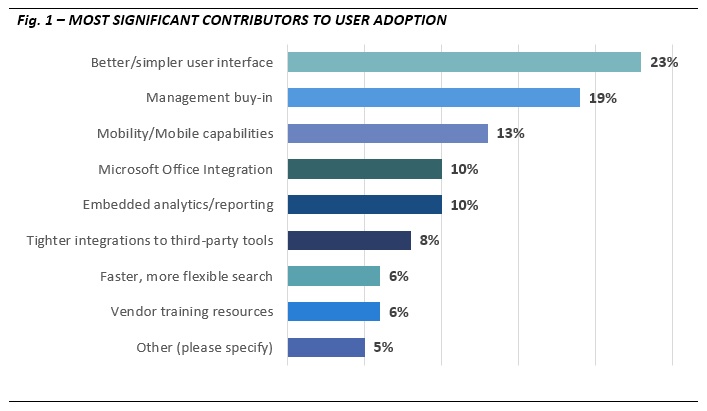
Conquering the Challenges of User Adoption
User adoption represents the most critical factor for successful technology deployment and ROI
For legal organizations in the process of implementing new technology solutions, we’re all too painfully aware of the challenges of adoption and motivating users to use new technology effectively. This challenge lies at the core of ROI. Historically, many of these adoption obstacles have often hinged on letdowns by the systems, especially as they relate to user experience. Users expect an experience that that jives with and complements their ingrained work routines, and often the simplest, often overlooked, factors, such as searching for their matters, can derail a new deployment. Other difficulties with adoption have had more to do with simple human apathy, such as attorney reluctance.
Opinions are often strong and passionate, and one industry insider recently framed the industry’s sentiments quite adeptly: “Without the promise and the delivery on the promise to make work better, simpler, more fun … and fulfillment of that promise by the product, it is going to be an uphill battle and require a lot of reminders and ‘babysitting’ by the first line manager.”
This “secret sauce” for user adoption lies at the heart of Hyperion Research’s latest benchmarking on the most effective contributors to legal technology adoption. As Fig. 1 below demonstrates, legal technology managers and administrators agree on three fundamental keys to user adoption: (1) the need for a top-down mandate, and more broadly, how the culture of work may affect the user enthusiasm for these systems, (2) how actually useful the technology is, and (3) the acute need for system integrations, which speak broadly to information accessibility.

Management Buy-In
With nearly one in five managers pointing to the need for management buy-in, the focus on clear objectives and goals by management is essential to software adoption. An organization without a top-down mandate for transformation will likely struggle to adapt actual every day activity. In organizations whose leadership is in agreement to launch—and enforce the use of—these systems, user adoption has a “stickiness” that is rarely accomplished otherwise. An important factor to that effort starts with the system selection process itself. Management needs to carefully assess the needs of attorneys, staff and other legal professionals – truly seek to understand the way people perform their work – and select software and tools that best support those values. The organizational business objectives that drive the need for technology in the first place can best harness genuine momentum by being thoughtfully aligned with meaningful improvements to “on the ground” ways of working.
Actual Usefulness
Most of the opinions in our benchmarking on adoption we dominated by factors related to actual usefulness of technology solutions. An array of features that actually support people in how they do their jobs in and out of the office, they include highly tactical factors such User Interface, Mobility, Search, Analytics and Reporting, and Microsoft Office integration. Independently, these features ostensibly support faster, better, more accurate and more seamless work. As we evaluate them in the aggregate, though, we begin to understand the multi-faceted dimensions that comprise true information management transformation. This is especially important as data-driven decision-making—and the sources and the quality of the data that enter the critical path—begin to drive operational maturity.
Accessibility
Perhaps more significantly than ever before, user adoption is broadly affected by issues of accessibility. In this context, accessibility is distinguished by a myriad of competencies that determine user interface, control, ease of use, location, and consistency of experience across devices and platforms. Accessibility today is defined and strongly influenced by the consumerization of IT. Users’ experiences with technology as consumers clearly, demonstrably and materially impact their expectations regarding their technology experiences at work. In fact, many legal technology selections today are capitalizing on the consumerization of IT and proliferation of mobile devices by seeking applications aimed at improving employee productivity and client satisfaction.


